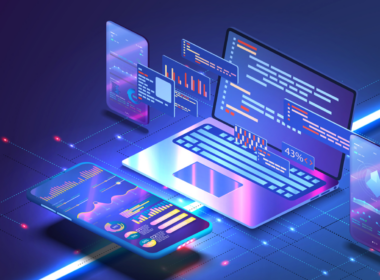Developing your own software might sound like a daunting task, but it’s a journey that can lead to incredible results, whether you’re building a simple app or a complex system. If you’re reading this, you’re likely considering taking the plunge into software development, perhaps driven by a unique idea or a need that existing solutions just can’t meet.
But let’s face it—software development isn’t just about writing code. It’s about problem-solving, understanding your end users, and constantly adapting to new challenges. Maybe you’ve been frustrated by off-the-shelf software that doesn’t quite fit your needs, or perhaps you’ve got a vision for something completely new. Whatever your reason, taking control and developing your own software can be both empowering and rewarding.
In this guide, we’ll break down the process into manageable steps, so you can turn your idea into reality. Whether you’re a seasoned developer or someone just starting out, these steps will help you navigate the complexities of software development with confidence. Let’s get started.
Basic Requirements for Developing Your Own Software
Just like building a house, you need to ensure that you have all the basic elements in place to support the more complex work that lies ahead. Let’s start by getting the essentials right—setting up your tools and environment properly. This groundwork will not only make your development process smoother but also help you avoid potential headaches down the line. So, to truly understand and succeed in software development, let’s break down the basics requirements first.
1. Development Computer: Your Coding and Testing Hub
The development computer is the heart of your software creation process. This is where you’ll write code, test it, and make continuous improvements. It’s crucial that this machine is up to the task, as the performance of your development computer directly impacts your productivity and workflow.
What to consider:
- Processing Power: A strong processor (CPU) is necessary to handle the demands of modern development environments. If you’re working on large projects or using resource-intensive tools, opt for a multi-core processor with high clock speeds.
- Memory (RAM): Sufficient RAM is essential for multitasking and running multiple applications simultaneously. A minimum of 16GB is recommended for most development tasks, though more may be needed for heavy-duty projects.
- Storage: An SSD (Solid State Drive) is preferable over traditional hard drives due to its speed, which will help reduce load times and make your overall development process smoother.
- Operating System: Depending on your project, you may need a specific operating system. For instance, iOS development requires macOS, while other types of software can be developed on Windows or Linux.
This machine is where you’ll spend most of your time, so investing in a reliable and efficient development computer will pay off in the long run.
2. Application Runtime Computer: Where Your Software Comes to Life
Once your software is developed, it needs a home where it can run reliably—this is where the application runtime computer comes into play. This machine could be anything from a dedicated server to an end user’s computer, depending on the nature of your software.
What to consider:
- Environment Compatibility: Ensure the runtime environment matches what you developed for. If your software is intended to run on multiple platforms (like Windows, macOS, and Linux), your runtime computer should be able to handle those environments.
- Performance Requirements: The runtime machine must meet the minimum requirements your software demands. For example, if your application is resource-intensive, it needs a runtime computer with sufficient processing power and memory.
- Security: Particularly important for server-based applications, the runtime environment should be secure and protected from potential vulnerabilities. Implementing firewalls, antivirus software, and regular updates can safeguard your application.
This step is crucial, as the performance of the application runtime computer will determine how smoothly your software runs in real-world scenarios.
3. Programming Language and Compiler: The Brains Behind Your Software
Choosing the right programming language and compiler is like picking the right ingredients for a recipe—they determine how well your software will function and how efficiently it can be developed. The programming language is what you’ll use to write your software, and the compiler translates that code into a language that your computer can understand and execute.
What to consider:
- Language Suitability: Different programming languages are better suited for different tasks. For example, Python is known for its simplicity and is great for web development and scripting, while C++ offers more control over system resources, making it ideal for performance-critical applications.
- Compiler Efficiency: A good compiler can make a significant difference in the speed and efficiency of your development process. It translates your high-level code into machine code, so faster and more optimized compilers can lead to better-performing applications.
- Community and Support: Opt for a language with a strong community and extensive resources. This will make it easier to find libraries, frameworks, and solutions to common problems. Popular languages like Java, Python, and JavaScript benefit from vast ecosystems of tools and support.
The choice of programming language and compiler will shape the entire development process, so choose wisely based on your project’s needs and your own comfort level with the language.
These three foundational components—your development computer, application runtime computer, and the programming language with its compiler—are essential for starting your software development journey on the right foot.
With the right tools and setup, you’ll be well-equipped to bring your software ideas to life. Ready to move on to the next step?
Now that you’ve set up the basic hardware and chosen your programming language, it’s time to focus on the tools that will help you streamline the development process and manage your code effectively.
You might be interested in knowing: The Process of Custom Software Development: A Step-by-Step Guide.
Software Development Tools
The right development tools can make a world of difference in your software development journey. They not only enhance your productivity but also ensure that your code is well-organized, efficient, and easy to manage. Let’s explore some essential tools you’ll need to get started.
1. Integrated Development Environment (IDE)
An Integrated Development Environment (IDE) is where you’ll spend most of your time writing and debugging code. Think of it as your digital workbench, equipped with everything you need to code efficiently. A good IDE combines a text editor, compiler, debugger, and other development tools into a single interface, making the coding process smoother and more intuitive.
Why VSCode?
- User-Friendly: Visual Studio Code (VSCode) is one of the most popular IDEs due to its user-friendly interface and versatility. It supports a wide range of programming languages, making it an excellent choice for both beginners and experienced developers.
- Extensions and Plugins: VSCode offers a vast library of extensions that can add functionality to your development environment. Whether you need linting tools, debuggers, or even themes to customize your workspace, VSCode has you covered.
- Performance: Despite its rich features, VSCode is lightweight and doesn’t consume too much system resources, allowing you to run it smoothly even on less powerful machines.
By using an IDE like VSCode, you’ll have all the tools you need in one place, which can significantly enhance your efficiency and help you focus more on writing quality code.
2. Source Code Repository: Managing Code Changes with Ease
As you start developing your software, managing your code becomes crucial—especially if you’re working with a team or on a complex project. This is where a source code repository comes into play. It helps you keep track of every change made to your codebase, revert to previous versions if necessary, and collaborate with others seamlessly.
Why GitHub?
- Version Control: GitHub is built on Git, a powerful version control system that allows you to manage changes to your code effectively. With GitHub, you can create branches to work on different features or bug fixes without affecting the main codebase, and then merge those changes back in when ready.
- Collaboration: GitHub makes it easy to collaborate with other developers. You can review code, manage pull requests, and discuss changes all within the platform. This is invaluable for team projects, but also useful if you’re flying solo and want to maintain a clean, organized project history.
- Community and Integration: GitHub is the largest host of source code globally, with a massive community of developers. It also integrates well with various tools and services, making it a central hub for your development activities.
Using a source code repository like GitHub ensures that your work is backed up, trackable, and easily manageable, which is key to maintaining quality as your project evolves.
3. Online Code Editors: Quick, Accessible Coding on the Go
Sometimes, you might need to write or test code quickly without setting up your full development environment. This is where online code editors come in handy. They’re accessible from any device with an internet connection, allowing you to code on the go or experiment with ideas without needing your main development computer.
Why CodePen?
- Instant Preview: CodePen is particularly popular for front-end development. It allows you to write HTML, CSS, and JavaScript code and see the results in real time, making it perfect for prototyping and experimenting with web design ideas.
- Community and Sharing: CodePen has a strong community of developers who share their work, so you can learn from others, get inspiration, or even collaborate on small projects. You can also easily share your own work or embed it in other sites, which is great for showcasing your skills or demonstrating concepts.
- Simplicity: While it’s not a full-fledged IDE, CodePen’s simplicity makes it ideal for quick tasks or learning new web technologies without the overhead of setting up a local environment.
Online code editors like CodePen provide a flexible, lightweight option for when you need to write code quickly or test ideas without the need for a complex setup.
With these development tools—an IDE like VSCode, a source code repository like GitHub, and online code editors like CodePen—you’ll be well-equipped to handle the different aspects of software development efficiently. These tools not only help you write and manage code effectively but also ensure that your development process is organized and productive.
With your tools in place, it’s time to decide on the technology stack that will form the backbone of your software. This choice impacts everything from development speed to performance and scalability, so let’s look at the essentials.
Choosing a Technology Stack
With your tools in place, it’s time to decide on the technology stack that will form the backbone of your software. This choice impacts everything from development speed to performance and scalability, so let’s look at the essentials.
1. Front End: Crafting the User Interface
The front end is what users interact with directly. It’s all about creating a seamless and engaging user experience.
- Frameworks: Consider popular options like React, Angular, or Vue.js to build dynamic and responsive UIs.
- Design: Tools like Bootstrap or Tailwind CSS can help you quickly develop a clean, responsive design.
2. Back End: Building the Core Logic
The back end handles the behind-the-scenes functionality of your application, including processing user requests and managing data.
- Languages and Frameworks: Choose from languages like Node.js (JavaScript), Python (Django), or Ruby (Rails) based on your needs.
- APIs: Building RESTful APIs or using GraphQL can streamline data exchange and integration with other services.
3. Data Layer: Managing Your Data
Your database choice is crucial for storing and retrieving data efficiently.
- Relational vs. NoSQL: Use MySQL or PostgreSQL for structured data, or opt for MongoDB if you need flexibility with unstructured data.
- Data Security: Ensure that you implement basic security measures like encryption and regular backups.
4. Common Technology Stacks: Pre-Built Efficiency
Leverage well-known technology stacks that have proven their effectiveness.
- MEAN/MERN: Both are JavaScript-based, with MEAN using Angular and MERN using React for the front end.
- LAMP: A classic stack with Linux, Apache, MySQL, and PHP, ideal for traditional web applications.
- Ruby on Rails: Simple and efficient, especially for startups looking to move fast.
These components will give you a solid foundation for your software, ensuring it’s built with the right tools for the job. Next, let’s focus on the core phases of software development.
With your groundwork set, it’s time to move forward into the heart of software development. This isn’t just about slinging code; it’s about following a structured path that ensures your software is built right, from the ground up.
Core Phases of Software Development
Developing your own software is like constructing a building—you need a solid blueprint, skilled execution, and thorough inspections to ensure everything stands strong. Let’s break down the key phases that will guide you from concept to completion.
1. Planning and Analysis: Laying the Foundation
Every great software project starts with a plan. This phase is where you clarify what you’re building, why you’re building it, and how it will meet the needs of your users.
- Define Objectives: Clearly outline what your software aims to achieve. Are you solving a specific problem, improving an existing process, or creating something entirely new?
- Gather Requirements: Understand the needs of your end-users and stakeholders. This involves collecting input and ensuring everyone is on the same page regarding what the software should do.
- Feasibility Study: Evaluate whether your goals are achievable given your resources, time, and technology. This is where you weigh the pros and cons before committing fully.
This phase sets the direction for everything that follows, making sure you’re building something that’s both useful and achievable.
2. Design: Crafting the Blueprint
With a clear plan in place, it’s time to design how your software will work and look. This phase is all about structure and aesthetics.
- Architectural Design: Outline the software’s overall structure. This includes deciding on modules, components, and how they’ll interact. It’s like drawing up the blueprints for a building.
- User Interface (UI) Design: Focus on the look and feel of your software. Good UI design is intuitive and user-friendly, making it easy for people to navigate and use your application.
- Prototype Development: Sometimes, it’s helpful to create a prototype—a basic version of your software to test ideas and get feedback before you dive into full development.
Design is where creativity meets functionality, ensuring that what you’re about to build is not only effective but also engaging for users.
Don’t compromise on design. Collaborate with Codewave for exceptional UI/UX that combines creativity with functionality, ensuring your software is both stunning and user-friendly. Let’s make your vision come to life with designs that truly engage!
3. Development: Bringing Your Vision to Life
This is where the real action happens—coding. Development is about turning your design into a working product.
- Coding: Developers write the actual code that makes your software function. This phase often involves multiple iterations, where code is written, tested, and refined.
- Integration: As different components of the software are developed, they need to be integrated into a cohesive whole. This ensures that all parts of the software work together seamlessly.
- Version Control: Using tools like Git helps manage changes in the codebase, keeping everything organized and avoiding conflicts as the team works simultaneously.
The development phase is where your ideas take shape, transforming from concepts on paper to tangible, functional software.
4. Testing: Ensuring Everything Works
Once the software is built, it’s crucial to test it thoroughly to catch and fix any issues before launch.
- Unit Testing: Individual components are tested to ensure they work correctly on their own.
- Integration Testing: After unit testing, components are tested together to check if they interact as expected.
- User Acceptance Testing (UAT): Finally, real users test the software to ensure it meets their needs and functions in real-world scenarios.
Testing is all about quality assurance, ensuring your software is reliable and bug-free when it’s released to users.
5. Deployment and Maintenance: Releasing and Refining
With testing complete, your software is ready to be released into the wild. But the work doesn’t stop there.
- Deployment: The software is launched and made available to users. This could be through an app store, a website, or a direct download.
- Maintenance: Post-launch, it’s important to monitor the software, fix any issues that arise, and make updates as needed. Maintenance ensures your software continues to function well and adapt to changing user needs.
Deployment is the beginning of your software’s life in the real world, and maintenance is key to keeping it relevant and effective.
The next critical element to consider is the approach you’ll take to manage and execute these phases effectively. This is where software development methodologies come into play, offering structured frameworks to guide your project from concept to completion.
Don’t Miss: Tips to Hire a Software Developer for a Startup
Popular Software Development Methodologies
Choosing the right development methodology can make a significant difference in how smoothly your project runs. Each methodology offers a different approach to planning, executing, and managing your software development process. Let’s take a look at some of the most popular ones.
1. Agile: Flexibility and Iteration
Agile is one of the most widely used methodologies today, particularly in environments where requirements may evolve throughout the project. Agile focuses on iterative development, where small, functional segments of the software are developed, tested, and reviewed in short cycles, known as sprints.
- Key Features: Flexibility, continuous feedback, and regular updates.
- Best For: Projects with changing requirements or those that need to deliver features incrementally.
- Pros: Encourages collaboration, improves product quality, and allows for quick adjustments.
- Cons: Can be challenging to manage without experienced teams, and constant changes can lead to scope creep.
2. Waterfall: Sequential and Structured
The Waterfall model is one of the oldest software development methodologies, offering a linear and sequential approach. Each phase must be completed before the next one begins, making it easy to manage and understand, especially for straightforward projects with well-defined requirements.
- Key Features: Clear stages, with a strong emphasis on documentation.
- Best For: Projects with stable, unchanging requirements where each phase can be thoroughly completed before moving on.
- Pros: Simplicity, clarity, and easy tracking of progress.
- Cons: Inflexibility in handling changes, and issues may not be discovered until later stages, making them harder to fix.
3. Scrum: A Framework Within Agile
Scrum is a specific Agile methodology that emphasizes teamwork, accountability, and iterative progress toward a well-defined goal. It divides work into small, manageable pieces called sprints, usually lasting two to four weeks.
- Key Features: Daily stand-up meetings, sprint reviews, and retrospectives.
- Best For: Teams looking for a structured way to implement Agile principles with clear roles and responsibilities.
- Pros: Strong team collaboration, fast delivery of small, usable features, and continuous improvement.
- Cons: Can become chaotic without a strong Scrum Master, and managing dependencies between sprints can be tricky.
4. DevOps: Bridging Development and Operations
DevOps is more than just a methodology; it’s a culture that blends software development (Dev) with IT operations (Ops). The goal is to shorten the development lifecycle and deliver high-quality software continuously. DevOps emphasizes automation, continuous integration, and continuous delivery (CI/CD).
- Key Features: Automation of the deployment process, continuous monitoring, and collaboration between development and operations teams.
- Best For: Environments where rapid deployment and continuous delivery are critical.
- Pros: Faster delivery, higher quality releases, and improved collaboration between teams.
- Cons: Requires a cultural shift, which can be difficult to implement, and significant upfront investment in automation tools.
5. Lean: Efficiency and Waste Reduction
Lean methodology, inspired by manufacturing principles, focuses on maximizing value by minimizing waste. In software development, this means cutting out anything that doesn’t directly contribute to delivering a working product.
- Key Features: Focus on value, efficient workflow, and continuous improvement.
- Best For: Projects where efficiency and cost reduction are top priorities.
- Pros: Streamlines processes, reduces costs, and improves productivity.
- Cons: Can be difficult to apply in projects with complex requirements, and overly aggressive waste-cutting can sometimes lead to missing out on valuable features.
Selecting the right methodology is crucial because it shapes how your team works together, how you manage changes, and ultimately, how successful your project will be. Understanding the strengths and challenges of each methodology will help you choose the best fit for your project’s unique needs.
As you begin to choose the right methodology and plan your project, it’s important to set yourself up for success from the very start. Here are some practical tips to help you get started on the right foot, especially if you’re new to software development.
Getting Started Tips for Developing your Own Software
Starting your software development journey can feel overwhelming, but with the right resources and strategies, you can make the process much smoother. Here are some actionable tips to help you kick things off:
1. Select Platforms like Amazon AWS or Microsoft Azure
Choosing the right platform to host your application is crucial, especially as you consider scalability and deployment. Cloud platforms like Amazon AWS and Microsoft Azure offer robust environments where you can deploy, test, and scale your software easily.
- Why It Matters: These platforms provide powerful tools for hosting, managing, and scaling applications. They’re also widely used in the industry, giving you valuable skills for future projects.
- Getting Started: Both AWS and Azure offer free tiers and student discounts, making them accessible options for beginners.
2. Utilize Student Resources and GitHub’s Student Pack
If you’re a student, take advantage of the numerous resources available to you. GitHub’s Student Developer Pack, for example, offers free access to premium tools and services that can significantly enhance your development process.
- Why It Matters: These resources provide you with industry-standard tools and services at no cost, allowing you to experiment and learn without financial constraints.
- Getting Started: Sign up for GitHub’s Student Pack and explore the various tools included, such as cloud credits, IDEs, and more.
3. Start with Simple Projects Like Input Mirroring or Dice Roller
When you’re just starting out, tackling a massive project can be intimidating. Instead, begin with simple projects that help you grasp the basics of coding and software development.
- Why It Matters: Simple projects build your confidence and understanding of coding principles without overwhelming you.
- Getting Started: Try creating a basic input mirroring app (where the output reflects what you type) or a dice roller, both of which involve simple logic and user interaction.
4. Take Introductory Coding Courses (e.g., Udemy)
Learning the fundamentals through structured courses can accelerate your progress. Platforms like Udemy offer a variety of coding courses tailored to beginners, covering everything from basic programming to specific technologies.
- Why It Matters: These courses provide guided learning paths, helping you build a strong foundation in programming and software development.
- Getting Started: Look for highly-rated beginner courses on platforms like Udemy, Coursera, or Codecademy to get started with the basics.
5. Explore Student Licenses/Trials for Generative Tools
Many advanced tools and software offer student licenses or free trials. These can give you access to powerful generative tools that are typically used in more advanced projects.
- Why It Matters: Access to these tools allows you to experiment with more sophisticated features and techniques, even as a beginner.
- Getting Started: Research and sign up for student licenses or free trials of tools like JetBrains IDEs, Figma, or Adobe Creative Cloud.
Armed with these tips, you’ll be well on your way to starting your software development journey with confidence. Each of these steps is designed to build your skills and understanding incrementally, making the complex world of software development more approachable.
It’s crucial to think about not just how you build your software, but also how you manage it and ensure it’s legally compliant. Let’s know the importance of source control and compliance to keep your project on the right track.
Source Control and Compliance
Managing your code and ensuring your software is compliant with legal standards are vital aspects of software development that shouldn’t be overlooked. Here’s why these elements are so important:
1. Use of Source Control Software Like GitHub
Source control is essential for managing your code effectively, especially as your project grows or if you’re working in a team. GitHub, built on the Git version control system, is the go-to platform for developers.
- Why It Matters: Source control allows you to track changes, collaborate with others, and revert to previous versions if something goes wrong. It’s like having a safety net for your code.
- Getting Started: Learn the basics of Git and GitHub, such as committing changes, branching, and merging, to keep your project organized and under control.
2. Importance of Adhering to Patents and Copyrights
As you develop your software, it’s crucial to ensure that you’re not infringing on anyone else’s intellectual property. Understanding and respecting patents and copyrights can save you from legal troubles down the line.
- Why It Matters: Violating patents or copyrights can lead to lawsuits, fines, and the forced cessation of your project. Ensuring compliance protects your work and keeps your project legally sound.
- Getting Started: Familiarize yourself with basic intellectual property laws and consider consulting a legal expert if you’re unsure about using certain technologies or content in your software.
By integrating source control practices and staying compliant with legal standards, you’ll protect both your code and your project’s future. These steps ensure that your development process is not only efficient but also safe from potential legal pitfalls.
Conclusion
While these tips provide a strong starting point for developing your own software, the difference between a good product and a truly exceptional one often comes down to experience and expertise. Navigating the complexities of software development is challenging, and that’s where partnering with a professional team can make all the difference.
At Codewave, we’ve helped countless innovators like you turn their ideas into reality. We don’t just develop software; we immerse ourselves in your vision, applying a design thinking mindset that ensures your software isn’t just functional but genuinely useful to your users. Whether you’re looking to launch a new product or refine an existing project, our team is here to guide you every step of the way, making your success our mission. Let’s create something extraordinary together.Tired of the ordinary? Let Codewave, with our design thinking approach, build software that hits the market with success. Ready to create something that stands out? Let’s make it happen together.
Codewave is a UX first design thinking & digital transformation services company, designing & engineering innovative mobile apps, cloud, & edge solutions.







